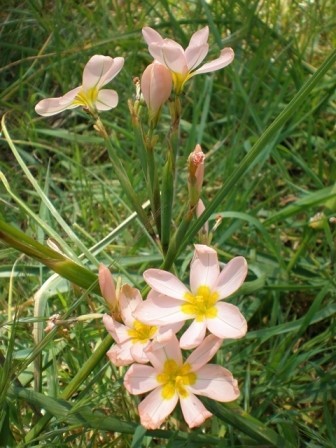Cape tulip (one-leaf (Moraea flaccida) and two-leaf (Moraea miniata)) is a highly invasive and toxic ‘bulb’ weed of native vegetation and pastures.
Description
Cape tulip is native to South Africa and was introduced to Australia as a garden plant. There are two species of this perennial herb (occurring year to year), which sprout leaves and flower annually.
Its corms (a type of bulb) germinate after autumn rains, growing quickly through winter. Plants have long strappy flat leaves 1–2 cm wide and 60–100 cm long.
The 6 petaled flowers, usually salmon pink or orange in colour with yellow centres, are produced in late winter to early spring on stems up to 60 cm high.
New corms begin to form in September, before the flowers appear. The aerial growth dies by November. Plants often don’t flower until their second or third year.
One-leaf cape tulip (Moraea flaccida):
- has a 1–2 cm diameter white corm covered in a brown fibrous tunic
- has a single leaf
- flowers are 3–5 cm in diameter
- fruit is an elongated capsule up to 5 cm long which starts green and turns brown when mature and can contain up to 150 seeds that are viable in the soil for up to 2 years
- reproduces vegetatively by corms (bulb-like) and by seed.
Two-leaf cape tulip (Moraea miniata):
- corms are 1–2.5 cm wide and covered with a hard black tunic
- usually has 2 leaves, sometimes 3 and rarely up to 5
- flowers are 2–4 cm in diameter, smaller and more numerous than one-leaf cape tulip
- does not produce seeds, even though small capsules sometimes form after flowering; instead, large numbers of cormils (tiny corms 1–2 mm long) form in the axil of each leaf and around the corm at the base of the plant
- reproduces vegetatively by corms and above-ground cormils.

Impacts
Cape tulip is a garden escapee which establishes in native vegetation. It blocks the growth and regeneration of native ground plants which displaces understory and degrades habitat for native insects, birds and animals.
Cape tulip also invades grazing paddocks reducing the quality of pasture. All parts of the plant are toxic to grazing animals, even when dried. As stock selectively graze out desirable pasture cape tulip can then spread further and degrade more pastures, and reduce stock carrying capacity.
Distribution
Cape tulip is widely naturalised in southern Australia and a common weed of pastures, roadsides, waste land and remnant bushland.
It is spread mostly by movement of contaminated equipment, agricultural produce and soil. Seeds and corms stick to wool and the feet of animals. Seeds are still viable after passing through stock. Dried, intact seed capsules are also spread by wind and running water.
Infestations are more common in higher rainfall areas on rural land and the urban fringes of Green Adelaide in a range of soil types. Scattered infestations also occur across the plains in urban reserves and on grazing properties.

Control
Cape tulip is a declared weed under the Landscape South Australia Act 2019.
The sale of Cape tulip or contaminated goods; and its movement on a public road are prohibited. It is the responsibility of the land owner to control these plants on their property.
We encourage the control of Cape tulip where there is a risk to biodiversity assets and agricultural enterprises.
Control methods
The key to managing this weed it to prevent establishment and spread. It is important to destroy new infestations before they become established.
Hygiene
Restrict movement of any contaminated machinery or soil and decontaminate equipment before leaving a site. Quarantine stock before moving to clean areas.
Hand removal
Although control by hand is difficult, due to many cormils which form around the basal corm, it is a suitable method for the odd plant or small patches growing in bushland. Carefully grub out the plant using a knife or trowel. Make sure the entire root system and all corms are extracted. These can then be burnt.
Chemical
Due to the plant’s fast but short growth there is only a small window of opportunity for herbicide control. Most effective treatments should be applied from early emergence to September, when leaf shoots first appear and well before flower buds appear, as this is the stage of corm exhaustion.
Select the appropriate method and herbicide for your situation. What may suit pasture control may not suit control in areas of native vegetation.
Targeted spot spraying using a knapsack sprayer suits small to medium infestations. A boom spray or wick wiper is more efficient for larger paddock infestations.
In bushland, where there may be a risk to off-target damage of native plants from spraying, apply herbicide using a sponge, weed tongs or a wick applicator.
For advice on chemical options go to PIRSA's Identifying declared weeds.
Monitor and follow up controls
As corms can stay dormant in the soil for 5–10 years herbicide treatments need to be applied over several seasons before any significant reduction is noticed.
Mechanical control
Slashing is ineffective and may increase spread by dispersing seed and cormils. Soil cultivation will also spread the corms.
Observations of weeds can be entered into iNaturalist, an app which can assist with identification of species.